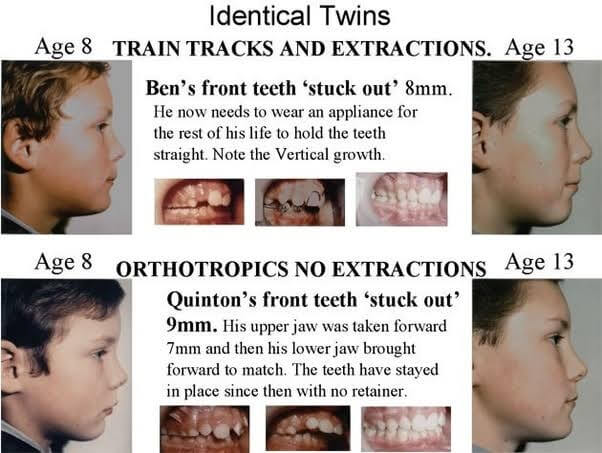The Differences Between Orthotropics and Orthodontics
On face value, orthodontics and orthotropics are very similar. They both seek to treat the same thing; however, they go about doing so in a very different way and, because of this, achieve vastly different outcomes - both in the short term and longterm. Orthotropics vs orthodontics is essentially a debate as to what causes malocclusion. Orthodontics blames genetics, while orthotropics blames poor postural and breathing habits.
Naturally, this difference of opinion is borne out in different treatment methods. Orthodontics seeks to straighten the teeth - often via
mechanical braces and tooth extraction to create space. Othrotropics, on the other hand, actively avoids extractions and instead looks to
correct posture - widening the maxilla so that the teeth and jaw will fall naturally into the correct position. The orthotropic rationale is
that straight teeth do not create a good looking face, but a good looking face will create straight teeth. Essentially, orthotropics is a
holistic approach to orthodontics, wherein it doesn't treat the symptom, but rather the cause.
Some other differences between orthotropics and orthodontics can be seen below:
Orthodontics
- Treatment mostly starts later in life after growth has finished - typically at ages 13+
- Treatment is done primarily via mechanical braces
- Extracts teeth to create space
Orthotropics
- Treatment starts as early as possible as it creates lifelong change
- Treatment makes us of orthopaedic appliances, not braces
- Expands and develops the maxilla and cranial bones to create space instead of extracting teeth
Expansion vs Extraction
The most significant difference between orthotropics and orthodontics is how they approach creating space for the teeth. Orthodontics commonly extracts teeth to create extra space, whereas orthotropics prefers to expand the mouth - specifically the maxilla - so that all teeth can fit. While the orthodontic idea of extraction is a relatively straightforward one to understand - it has, after all, been commonplace for decades - the orthotropic idea of expansion is a little more complicated. It has nothing to do with the teeth themselves, but instead, concentrates on the position of the tongue.
The tongue is the strongest muscle in the mouth, and orthotropics believe its position or natural resting place bears the greatest influence on facial posture. Orthotropists believe it is the tongue that dictates where the teeth sit. Ideally, the tongue will sit firmly against the roof of the mouth, which forces both the lower and upper jaw to make contact - ultimately ensuring the mouth is closed. When the mouth is closed, the top jaw is typically pushed forward and widened - creating balance, symmetry, and, most importantly, room for the teeth.
The inverse, however - where the mouth remains open at rest - causes the top jaw to narrow and shorten, and drags the bottom jaw downwards and backwards. This creates a longer, flatter face, an undershot chin or 'overbite', and ultimately leaves less room for the teeth. This condition is often the result of an everyday habit; breathing through the mouth instead of the nose.
The Difference in Appliances
Because orthodontics and orthotropics each employ a different style of treatment, the function of appliances also differs, as do the appliances themselves. Braces are the favoured appliance of the orthodontist - designed to force the teeth into alignment. The orthotropist, on the other hand, actively avoids the use of braces wherever possible. Instead, they favour 'removable expansion appliances' that are designed to correct posture, widen the maxilla and allow the teeth to fall into place naturally. It is important to note that braces are 'fixed' to the teeth, whereas orthotropic appliances are 'removable'.
The Age of Treatment
Another noteworthy difference between orthotropics and orthodontics is the age at which treatment commences. As orthodontics is concerned mainly with straightening the teeth, doing so before the face (and teeth) have fully formed, is a futile endeavour. Thus, the average age of treatment is higher - typically 13 and above. In orthotropics, however, it is advised that treatment begin when the patient is young so that the foundations for proper facial growth are laid - thereby negating the need for surgical intervention later in life (which is typical in more severe cases).
The age at which treatment can begin is a particularly significant difference between the two, as it supports the idea that orthotropics is a softer, less invasive form of intervention. By addressing issues in the early stages, they are unable to take a firm hold, and therefore longer-lasting results may be achieved. In fact, facial growth guidance is often able to correct issues for life. In contrast, the results obtained by way of orthodontics will - especially in the more severe cases - can occasionally regress over time, as the underlying causes of poor facial growth are ignored.
Orthodontics vs Orthotropics: Achieving Different Results
Of course, none of the above matters if there are no discernible differences in the outcomes achieved by each school of thought. The truth, however, is that orthotropic treatment produces vastly different results to traditional orthodontics. To better understand this, you only have to look at the studies conducted on identical twins - one of whom is treated by conventional orthodontics, and the other by orthotropics.


